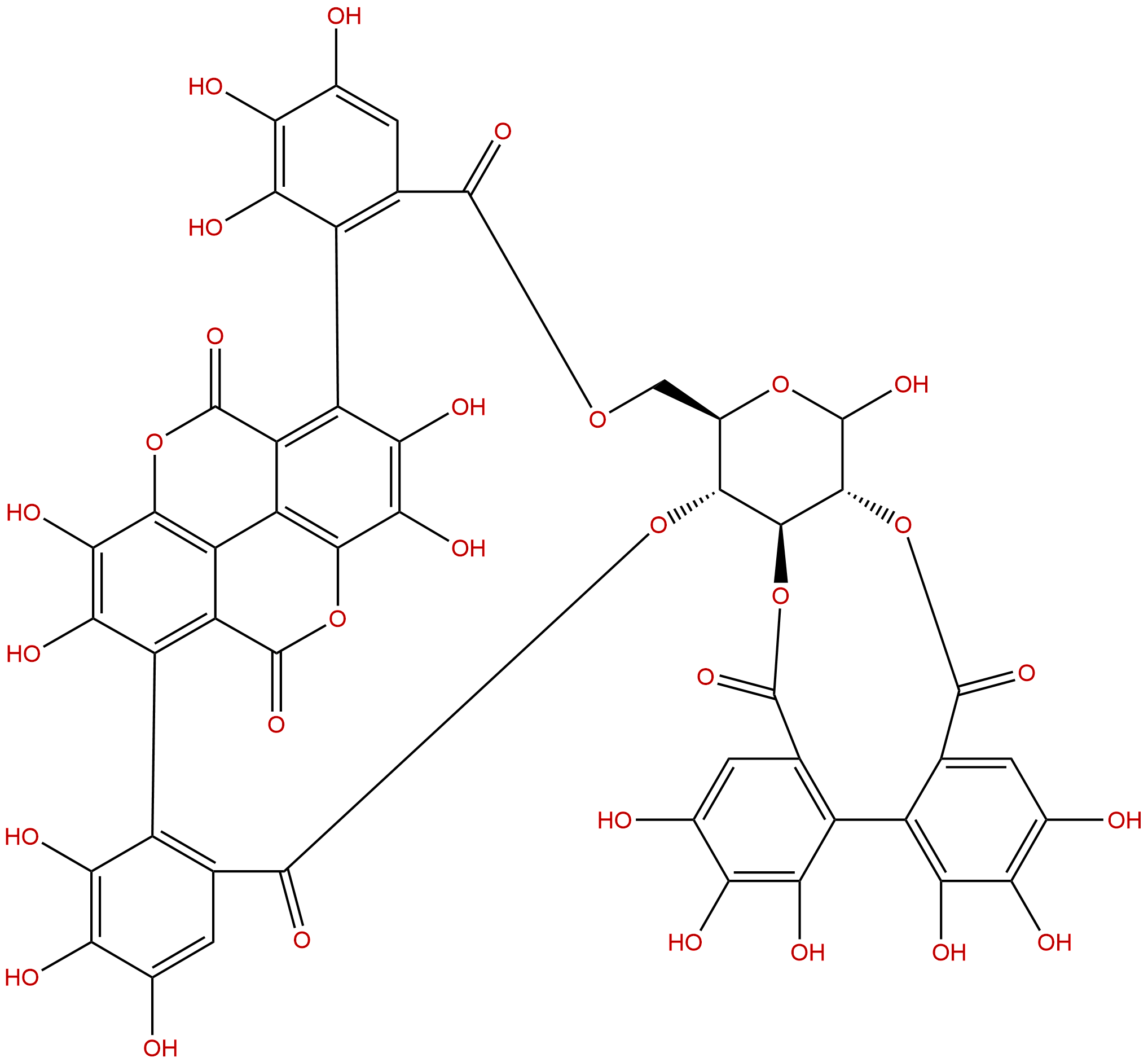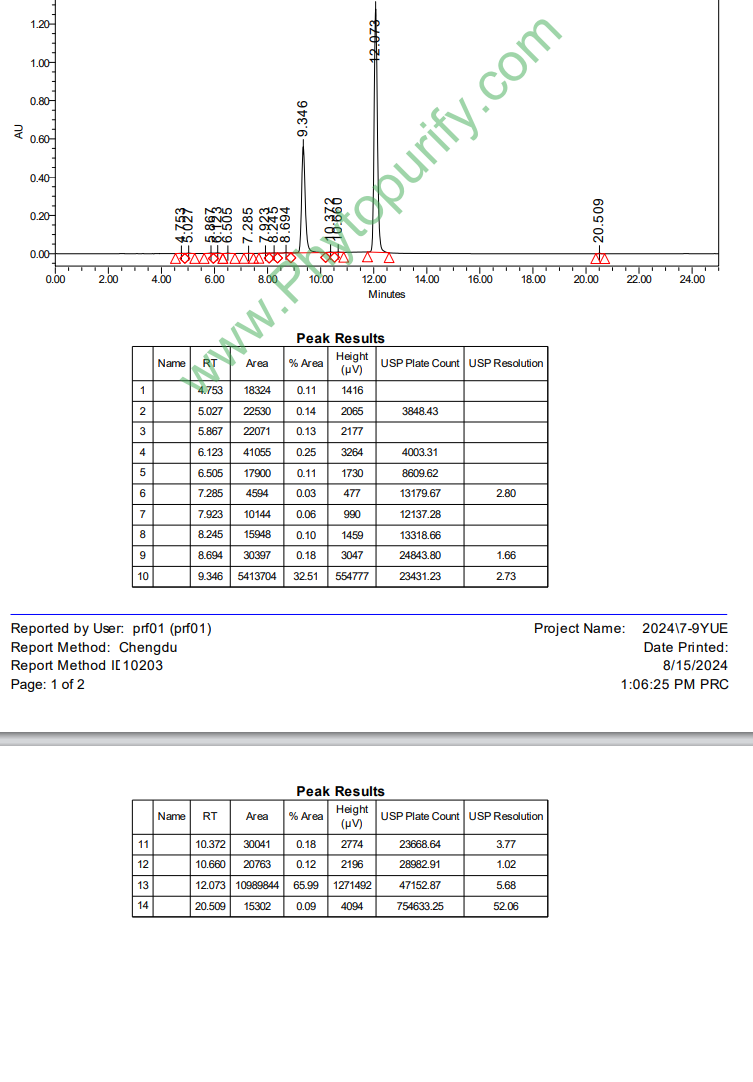
PunicalaginCAS No.:65995-63-3
|
||||||||||
 |
|
|
||||||||

| Catalogue No.: | BP1181 |
| Formula: | C48H28O30 |
| Mol Weight: | 1084.72 |
Product name: Punicalagin
Synonym name:
Catalogue No.: BP1181
Cas No.: 65995-63-3
Formula: C48H28O30
Mol Weight: 1084.72
Botanical Source: Punica granatumL.
Physical Description:
Type of Compound: Polyphenols
Purity: 95%~99%
Analysis Method: HPLC-DAD or/and HPLC-ELSD
Identification Method: Mass, NMR
Packing: Brown vial or HDPE plastic bottle
Storage: Store in a well closed container, protected from air and light. Put into refrigerate or freeze for long term storage.
Whenever possible, you should prepare and use solutions on the same day. However, if you need to make up stock solutions in advance, we recommend that you store the solution as aliquots in tightly sealed vials at -20℃. Generally, these will be useable for up to two weeks.
The product could be supplied from milligrams to grams
Inquire for bulk scale.
Description:
Punicalagin has antifungal , antiviral, anti-atherosclerotic, hepatoprotective , anti-obesity., antiproliferative, anti-apoptotic, anti-inflammatory, and antioxidant effects. It can suppress the phosphorylation of MAPK including p38, c-JNK, and ERK, it also has potently inhibiting the activity of fatty acid synthase with half-inhibitory concentration values (IC 50 ) of 4.50μM.
References:
Ann Clin Microbiol Antimicrob. 2014 Sep 5;13(1):32.
Antifungal activity of pomegranate peel extract and isolated compound punicalagin against dermatophytes.
Dermatophyte species infect the epidermis and appendages, often with serious social and health-economic consequences. The hydroalcoholic extract of pomegranate fruit peel showed activity against the dermatophyte fungi Trichophyton mentagrophytes, T. rubrum, Microsporum canis and M. gypseum.
METHODS AND RESULTS:
Hydroalcoholic extract was prepared with pomegranate peels. This crude extract was fractionated and submitted to liquid-liquid partition, resulting in an active fraction which was fractionated in a Sephadex LH-20 column, followed by a Lobar column. The structure of the active compound was established with the use of spectroscopic methods. The crude extract of pomegranate fruit peel showed activity against the dermatophytes Trichophyton mentagrophytes, T. rubrum, Microsporum canis, and M. gypseum, with MICs values of 125 μg/ml and 250 μg/ml, respectively for each genus. Punicalagin was isolated and identified by spectroscopic analysis. The crude extract and Punicalagin showed activity against the conidial and hyphal stages of the fungi. The cytotoxicity assay showed selectivity for fungal cells than for mammalian cells.
CONCLUSIONS:
These results indicated that the crude extract and Punicalagin had a greater antifungal activity against T. rubrum, indicating that the pomegranate is a good target for study to obtain a new antidermatophyte medicine.
Appl Environ Microbiol. 2014 Oct;80(19):6204-11.
Punicalagin inhibits Salmonella virulence factors and has anti-quorum-sensing potential.
Punicalagin, an essential component of pomegranate rind, has been demonstrated to possess antimicrobial activity against several food-borne pathogens, but its activity on the virulence of pathogens and its anti-quorum-sensing (anti-QS) potential have been rarely reported. This study investigated the efficacy of subinhibitory concentrations of Punicalagin on Salmonella virulence factors and QS systems.
METHODS AND RESULTS:
A broth microdilution method was used to determine the MICs of Punicalagin for 10 Salmonella strains. Motility assay and quantitative reverse transcription (RT)-PCR were performed to evaluate the effects of Punicalagin on the virulence attributes and QS-related genes of Salmonella. The MICs of Punicalagin for several Salmonella strains ranged from 250 to 1,000 μg/ml. Motility assays showed that Punicalagin, at 1/16× MIC and 1/32× MIC, significantly decreased bacterial swimming and swarming motility, which corresponded to downregulation of the motility-related genes (fliA, fliY, fljB, flhC, and fimD) in RT-PCR assays. RT-PCR also revealed that Punicalagin downregulated the expression of most of the selected genes involved in Salmonella virulence. Moreover, a QS inhibition assay indicated that Punicalagin dose dependently inhibited the production of violacein by Chromobacterium violaceum and repressed the expression of QS-related genes (sdiA and srgE) in Salmonella. In addition, Punicalagin significantly reduced Salmonella invasion of colonic cells (P<0.01) with no impact on adhesion.
CONCLUSIONS:
These findings suggest that Punicalagin has the potential to be developed as an alternative or supplemental agent for prevention of Salmonella infection.
Phytother Res. 2001 May;15(3):206-12.
Antioxidant and hepatoprotective effects of punicalagin and punicalin on acetaminophen-induced liver damage in rats.
Punicalagin and punicalin were isolated from the leaves of Terminalia catappa L., a Combretaceous plant distributed throughout tropical and subtropical beaches, which is used for the treatment of dermatitis and hepatitis. Our previous studies showed that both of these compounds exert antioxidative activity.
METHODS AND RESULTS:
In this study, the antihepatotoxic activity of Punicalagin and punicalin on acetaminophen-induced toxicity in the rat liver was evaluated. After evaluating the changes of several biochemical functions in serum, the levels of aspartate aminotransferase (AST) and alanine aminotransferase (ALT) were increased by acetaminophen administration and reduced by Punicalagin and punicalin. Histological changes around the hepatic central vein and oxidative damage induced by acetaminophen were also recovered by both compounds. The data show that both Punicalagin and punicalin exert antihepatotoxic activity, but treatment with larger doses enhanced liver damage.
CONCLUSIONS:
These results suggest that even if Punicalagin and punicalin have antioxidant activity at small doses, treatment with larger doses will possibly induce some cell toxicities.
Biochem Biophys Res Commun. 2008 Jul 11;371(4):799-803.
Immune-suppressive activity of punicalagin via inhibition of NFAT activation.[Pubmed: 18466764]
Since T cell activation is central to the development of autoimmune diseases, we screened a natural product library comprising 1400 samples of medicinal herbal extracts, to identify compounds that suppress T cell activity.
METHODS AND RESULTS:
Punicalagin (PCG) isolated from the fruit of Punica granatum was identified as a potent immune suppressant, based on its inhibitory action on the activation of the nuclear factor of activated T cells (NFAT). PCG downregulated the mRNA and soluble protein expression of interleukin-2 from anti-CD3/anti-CD28-stimulated murine splenic CD4+ T cells and suppressed mixed leukocytes reaction (MLR) without exhibiting cytotoxicity to the cells. In vivo, the PCG treatment inhibited phorbol 12-myristate 13-acetate (PMA)-induced chronic ear edema in mice and decreased CD3+ T cell infiltration of the inflamed tissue.
CONCLUSIONS:
These results suggest that PCG could be a potential candidate for the therapeutics of various immune pathologies.
Phytomedicine. 2012 Dec 15;20(1):67-70.
Antiviral activity of punicalagin toward human enterovirus 71 in vitro and in vivo.
Human enterovirus 71 is one of the major causative agents of hand, foot and mouth disease in children and has caused mortalities in large-scale outbreaks in the Asia-Pacific region in recent years. No vaccine or antiviral therapy is available currently in the clinic.
METHODS AND RESULTS:
In this work, we investigated the antiviral effect of Punicalagin on enterovirus 71 both in vitro and in vivo. The results showed that Punicalagin reduced the viral cytopathic effect on rhabdomyosarcoma cells with an IC₅₀) value of 15 μg/ml. Moreover, Punicalagin treatment of mice challenged with a lethal dose of enterovirus 71 resulted in a reduction of mortality and relieved clinical symptoms by inhibiting viral replication.
CONCLUSIONS:
Our work suggested that Punicalagin have the potential for further development as antiviral agents against enterovirus 71.
HPLC of Punicalagin
